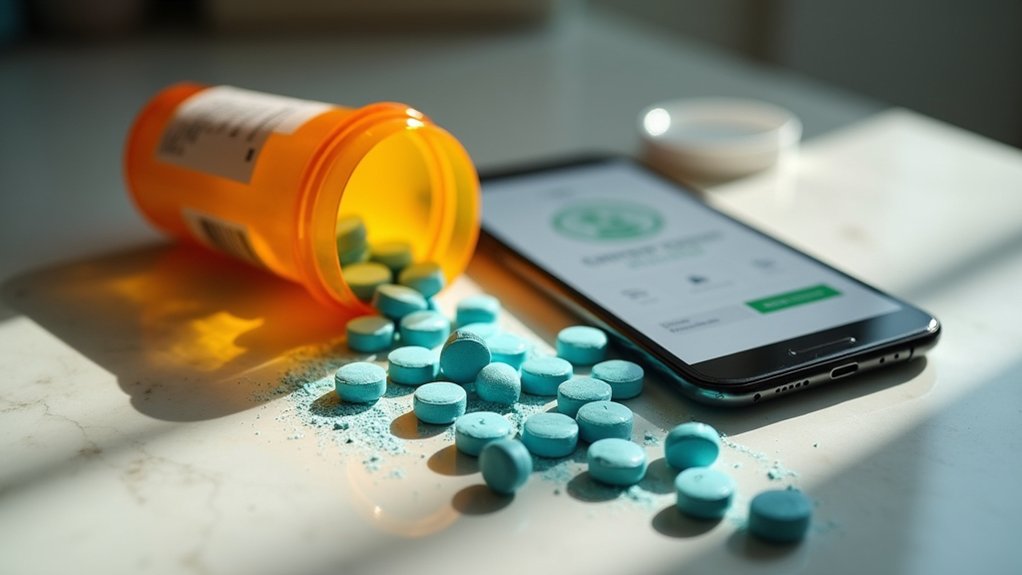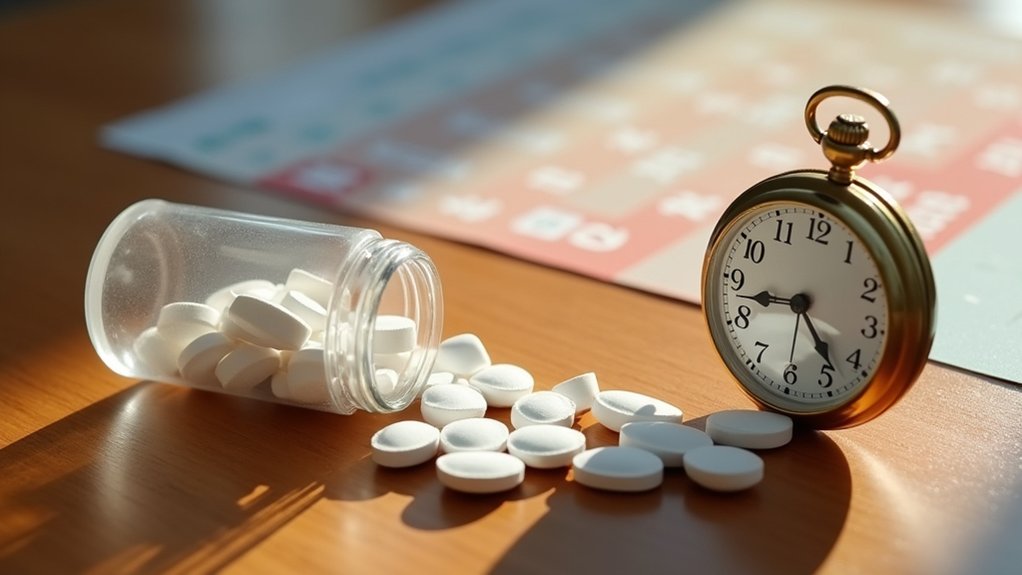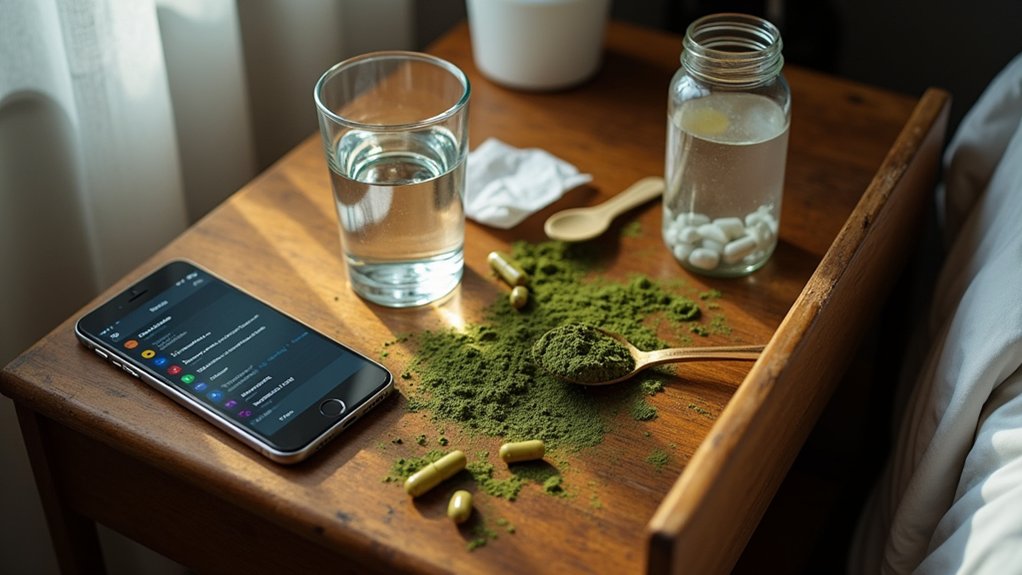To successfully overcome drug addiction, you’ll need a thorough approach that addresses both physical and psychological aspects of recovery. Start by accepting your condition and seeking professional medical support for proper assessment and treatment. Build a strong support network, identify your personal triggers, and establish new daily routines focused on healthy activities. Track your progress, celebrate milestones, and maintain wellness practices. This proven seven-step strategy offers your best path toward lasting recovery.
Accepting the Reality of Addiction and Taking Action

While confronting addiction can feel overwhelming, understanding it as a chronic mental health condition affecting over 21 million Americans helps normalize the experience and sets the stage for meaningful change. Your journey toward addiction awareness begins with accepting that substance use disorder isn’t a moral failing – it’s a complex health condition influenced by genetics, environment, and mental health factors. Security measures are continuously updated to protect online addiction resources and support services.
Don’t let denial hold you back. Statistics show that 96.8% of those needing treatment convince themselves they don’t need help. By acknowledging your struggle, you’re already ahead of the curve. Research shows that early drug use significantly increases the likelihood of developing substance dependence problems later in life. This reality is especially concerning since young adults between 18-25 are most likely to use addictive drugs. Remember, addiction impacts every aspect of life, from relationships to career, but recovery is possible with proper support. Take comfort knowing that seeking help isn’t a sign of weakness; it’s a powerful step toward reclaiming control of your health and future.
Building Your Medical Support Team and Treatment Plan
Once you’ve acknowledged the need for treatment, assembling the right medical team becomes your essential next step toward recovery. Look for an interdisciplinary team that includes physicians specialized in addiction medicine, nurses, counselors, and mental health professionals who’ll work together to create your extensive treatment plan.
Your team will conduct thorough assessments of your substance use, mental health, and medical needs to develop personalized treatment protocols. They’ll determine if you need medication-assisted treatment, supervised detoxification, or specific therapies for co-occurring conditions. Studies have shown that incorporating peer support services can significantly improve treatment retention and outcomes. Treatment typically begins with next-day care following your initial assessment. You’ll receive a combination of individual counseling, group therapy, and possibly peer support to address both the physical and psychological aspects of addiction. Research shows that active participation in treatment programs leads to significantly better recovery outcomes.
Creating a Strong Recovery Network for Long-Term Success

Because sustained recovery depends heavily on social connections, building a strong support network becomes your crucial next step after establishing medical care. Research shows that people with robust support systems have considerably higher recovery success rates and lower relapse risks. Your social investment in recovery-oriented relationships directly impacts your long-term success. Studies indicate that 2.1 million people participated in self-help support groups, demonstrating the widespread adoption of community-based recovery approaches. The data reveals that 75 percent of individuals achieve recovery from addiction with proper support systems. Having a broader support network has been shown to help reduce stress levels during the recovery journey.
- Join peer support groups like AA or NA; these proven communities offer understanding, accountability, and practical recovery strategies
- Reconnect with non-using family and friends who support your recovery journey
- Explore faith-based programs, sports teams, or volunteer opportunities to expand your recovery engagement
- Consider recovery residences like Oxford Houses where peer support and positive social norms reinforce your sobriety goals
Remember: larger, more diverse support networks provide multiple layers of protection against relapse while enhancing your overall well-being.
Understanding and Managing Your Personal Triggers
You’ll need to carefully examine the people, places, and situations that consistently trigger your urges to use drugs, paying special attention to social circles or locations where substances are readily available. Breaking away from toxic relationships and environments that encourage drug use is essential for your recovery, even if these changes feel difficult at first. You can strengthen your resistance to environmental triggers by creating new routines that involve substance-free activities and connecting with people who support your sobriety. Daily mindfulness practice can significantly reduce the intensity of cravings when they arise. Working with a therapist can help you explore underlying emotional states that may be fueling your cravings. Keeping a detailed trigger response journal can help you identify patterns and develop more effective strategies for managing your cravings over time.
Identifying Environmental Risk Factors
Environmental triggers play a pivotal role in both developing and sustaining addiction patterns. Understanding your surroundings and identifying risk factors helps create effective strategies for long-term recovery. Your environment’s impact on addiction risk stems from complex interactions between neighborhood dynamics, parental supervision, cultural attitudes, and socioeconomic factors. Studies show that residing in areas with neighborhood disorder can significantly increase substance use as a coping mechanism. Regular exposure to substance-using friends can drastically increase the likelihood of developing similar behaviors.
To identify your environmental risk factors, assess these key areas:
- Family dynamics – Consider how household stress, conflict, or exposure normalization affects your recovery
- Community resources – Evaluate access to healthcare, support services, and positive recreational outlets
- Social circles – Examine how your peer groups, media consumption, and cultural influences impact triggers
- Trauma exposure – Recognize how past experiences and stressful environments contribute to addiction patterns
Research shows that genetic markers contribute about half of the total risk for addiction development, making it crucial to understand both inherited and environmental vulnerabilities.
Breaking Toxic Social Patterns
Breaking free from toxic social patterns starts with understanding your personal triggers – the specific social situations, relationships, and behaviors that fuel addictive patterns. To build emotional resilience, you’ll need to identify and distance yourself from toxic friendships that normalize substance use. Research shows that adolescent brain development makes young people particularly vulnerable to peer pressure and substance use. Replace peer pressure with positive influences by connecting with sober, supportive individuals through community support groups and structured activities.
Combat social isolation by developing healthy coping strategies and stress management techniques. You’re more likely to maintain sobriety when you build a network of people who champion your recovery. Focus on strengthening family bonds, participating in prosocial activities, and accessing mental health resources when needed. Remember, your environment shapes your choices; surround yourself with those who reinforce your commitment to staying clean.
Developing New Daily Routines and Healthy Habits

You’ll need to consciously rebuild your daily schedule to create stability and reduce the risk of relapse during recovery. Establishing fixed times for meals, work, exercise, rest, and recovery activities helps eliminate dangerous gaps of unstructured time that could trigger substance use. Your new routines should incorporate healthy alternatives like support group meetings, self-care practices, and positive social connections to replace old patterns centered around drug use.
Restructure Your Daily Schedule
Establishing a structured daily routine stands as one of the most powerful tools in addiction recovery. When you create predictable daily activities, you’re building a foundation that helps minimize stress and reduce relapse risks. Your brain and body will respond positively to these structured routines, making healthy habits become automatic over time.
- Block out specific times for essential activities like waking up, meals, therapy sessions, and exercise
- Include regular slots for support meetings and counseling to maintain accountability
- Schedule dedicated rest periods and a consistent bedtime to reset your sleep patterns
- Plan enjoyable, non-risk activities during vulnerable times when you might typically feel triggered
Replace Unhealthy Activity Patterns
With a structured daily schedule in place, the next step focuses on replacing old patterns with meaningful activities that support your recovery. You’ll need to adopt exercise alternatives and nutrition strategies that promote physical and mental well-being while building positive new habits.
| Activity Type | Specific Actions |
|---|---|
| Physical Health | Daily walks, cycling, yoga |
| Nutrition | Meal planning, cooking classes |
| Achievement | Education, volunteering |
| Mindfulness | Meditation, journaling |
Research shows it takes about 66 days to form new habits, so don’t get discouraged if changes don’t happen overnight. Focus on activities that provide both immediate benefits and long-term rewards. Exercise helps reduce cravings and improves mood, while proper nutrition stabilizes energy levels. Combine these with achievement-oriented goals and mindfulness practices to create a thorough approach that strengthens your recovery journey.
Celebrating Milestones and Tracking Progress
Achievement markers along the recovery journey serve as powerful testimony to your commitment and progress in beating drug addiction. Understanding milestone significance helps you recognize the transformative impact of each day, week, and year of sobriety. You’ll find that tracking your progress fuels motivation and strengthens your resolve to maintain a drug-free life.
- Use mobile apps like SoberTool or Nomo to monitor your sobriety streaks, savings, and triggers
- Share your achievements with support groups to receive community validation and encouragement
- Celebrate milestones with recovery-aligned activities that reinforce your commitment to sobriety
- Document your progress through journaling or validated scales to measure your quality-of-life improvements
Maintaining Lifelong Wellness and Personal Growth
Successfully maintaining long-term recovery requires a thorough approach to wellness that extends far beyond initial sobriety. You’ll need to build sustainable habits that support both your physical and emotional health through regular exercise, proper nutrition, and mindfulness practices.
Focus on your personal growth by pursuing education, developing new skills, or engaging in volunteer work. These activities not only enhance your sense of purpose but also contribute to your long-term stability. Statistics show that 80% of people in recovery achieve significant life milestones, such as advancing their careers or earning degrees.
Stay connected to your community through support groups and healthy relationships. When you combine these elements with ongoing mental health care and financial planning, you’re creating a robust foundation for lasting recovery that supports your overall well-being.
Frequently Asked Questions
How Long Does It Typically Take for Drug Cravings to Stop Completely?
You’ll typically experience a significant reduction in drug cravings after 6-12 months, but complete cessation varies widely. While most people report minimal to no cravings after 2 years, some may have occasional triggers throughout their lives. Your craving duration depends on factors like addiction severity, substance type, and mental health. Implementing effective coping strategies, including therapy and lifestyle changes, can help you manage and reduce cravings more quickly.
Can Medication-Assisted Treatment Lead to a Different Type of Addiction?
While MAT medications carry medication risks, they’re clinically different from the dangerous addiction cycles you’re trying to break. Under proper medical supervision, you won’t typically develop a new addiction. Instead, you’ll receive controlled doses that help manage withdrawal and cravings safely. Your doctor will monitor you closely and create a personalized plan to prevent dependency. Remember, MAT medications like naltrexone are non-addictive, while methadone and buprenorphine require careful oversight to guarantee safe use.
What Percentage of People Achieve Permanent Recovery After Their First Attempt?
You should know that less than 50% of people achieve permanent recovery after their first attempt. Recovery statistics show that most individuals need about two serious attempts before achieving lasting sobriety. Don’t be discouraged by this; it’s similar to managing other chronic conditions. While your first attempt may not lead to permanent recovery, each try builds valuable experience and coping skills. Remember, more than 75% of people eventually achieve lasting recovery through persistence.
Should I Tell My Employer About My Addiction and Recovery Journey?
Your decision about workplace disclosure should be carefully weighed against your specific circumstances. Consider your employer’s policies, workplace culture, and your need for accommodations. If you’re in a safety-sensitive position, disclosure may be mandatory. While employer support can enhance your recovery journey through EAPs and accommodations, stigma remains a real concern. You’ll want to research your company’s substance use policies and anti-discrimination protections before making this personal decision.
How Do I Rebuild Trust With Family Members Who’ve Lost Faith?
Start rebuilding trust by demonstrating consistent, honest behavior over time; your actions will speak louder than words. Practice open family communication by sharing your recovery progress, acknowledging past hurts, and listening without defensiveness. You’ll need to be patient, as rebuilding trust takes time. Participate in family therapy sessions and support groups together, which can create safe spaces for healing and help restore damaged relationships.











